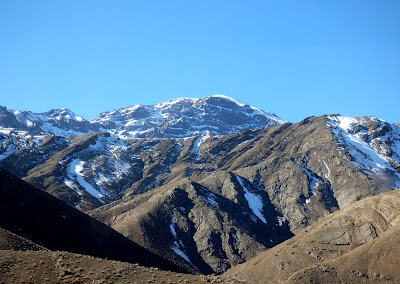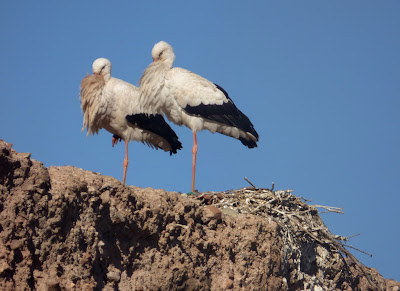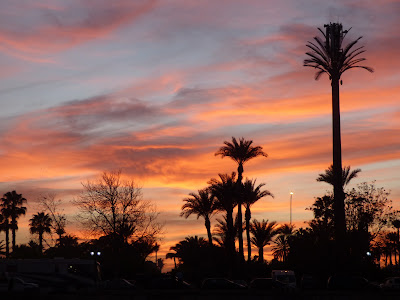Al día siguiente de ir a Essaouira, realizamos nuestra segunda excursión (esta vez de dos días) camino a Zagora, una de las últimas poblaciones de Marruecos ya cercana a Algeria y una de las "puertas" del Sahara, donde la piedra comienza a desaparecer, para dejar camino únicamente a la arena.
The next day to go to Essaouira, we made our second excursion (this time of two days) on the way to Zagora, one of the last towns in Morocco already close to Algeria and one of the "gates" of the Sahara, where the stone begins to disappear , to leave way only to the sand.
The next day to go to Essaouira, we made our second excursion (this time of two days) on the way to Zagora, one of the last towns in Morocco already close to Algeria and one of the "gates" of the Sahara, where the stone begins to disappear , to leave way only to the sand.
The van trip is quite long, but it is not weary at all because the landscapes are spectacular throughout the journey and are constantly changing. From the mixed forests at the beginning of crossing the Atlas, high mountain areas with snow in the highest areas near the ports, semi-arid, arid and finally desert areas, through riversides in the few streams that flow and through the impressive palm grove of the Draa, considered the second largest in Africa after the Nile´s.
garcilla bueyera (Bubulcus ibis) Cattle egret
tórtola senegalesa (Streptopelia senegalensis) laughing dove
Escribano sahariano (Emberiza sahari) House bunting
collalba yebélica (Oenanthe laucopyga) White-crowned black wheatear
Durante el trayecto así como en las paradas que fuimos realizando (pasando la noche en un campamento de jaimas en el desierto), pude seguir sumando más especies nuevas (y alguna ya mencionada en la entrada anterior); tórtola senegalesa (Streptopelia senegalensis), busardo moro (Buteo ruffinus), alcaudón norteño (Lanius excuvitor algeriensis), chova piquirroja (Pyrrhocorax pyrrhocorax), cuervo desertícola (Corvus ruficollis), cogujada montesina (Galerida theklae), cogujada común (Galerida cristata), avión roquero, (Ptyonoprogne rupestris), colirrojo tizón (Phoenicurus ochruros), roquero solitario (Monticola solitarius), tarabilla común (Saxicola rubicola), collalba negra (Oenanthe leucura), collalba yebélica (Oenanthe laucopyga) y bisbita pratense (Anthus pratensis).
During the journey and the stops we were making (spending the night in a desert camp of jaimas), I could continue adding more new species (and some already mentioned in the previous entry); Laughing dove, long-legged buzzard, Great grey shrike, Red-billed chough, Brown-necked raven, Thekla lark, Common lark, Crag martin, Common redstart, Blue rock thrush, European stonechat, Black whetaear, White-crowned black wheatear and Meadow pipit.
En nuestro último día en tierras marroquíes visitamos el parque de los Jardines de la Menara, dónde pude sumar las últimas especies al viaje; abubilla (Upupa epops), avión paludícola africano (Riparia paludicola), urraca magrebí (Pica mauritanica) y un ejemplar juvenil de halcón borní (Falco biarmicus).
On our last day in Moroccan lands we visited the park of the Jardines of the Menara, where I could add the last species to the trip; Hoopoe, Grey-throated Martin, Maghreb magpie and a juvenile specimen of the Lanner falcon.
En conclusión, Marruecos es un destino muy interesante para visitar, sea cual se a el motivo y por mi parte espero poder volver para poder realizar un viaje puramente ornitológico, ya que cuenta con una rica biodiversidad y especies esteparias que tengo muchas ganas de observar.
In conclusion, Morocco is a very interesting destination to visit, whatever the reason and for my part I hope to return soon to be able to make a purely ornithological trip, due it has a rich biodiversity and steppe species that I really want to observe.
During the journey and the stops we were making (spending the night in a desert camp of jaimas), I could continue adding more new species (and some already mentioned in the previous entry); Laughing dove, long-legged buzzard, Great grey shrike, Red-billed chough, Brown-necked raven, Thekla lark, Common lark, Crag martin, Common redstart, Blue rock thrush, European stonechat, Black whetaear, White-crowned black wheatear and Meadow pipit.
alcaudón norteño (Lanius excuvitor algeriensis) Great grey shrike
collalba yebélica (Oenanthe laucopyga) White-crowned black wheatear
Escribano sahariano (Emberiza sahari) House bunting
collalba negra (Oenanthe leucura) Black wheatear
collalba negra (Oenanthe leucura) Black wheatear
Lavandera blanca (Motacilla alba subpersonata) White wagtail
En nuestro último día en tierras marroquíes visitamos el parque de los Jardines de la Menara, dónde pude sumar las últimas especies al viaje; abubilla (Upupa epops), avión paludícola africano (Riparia paludicola), urraca magrebí (Pica mauritanica) y un ejemplar juvenil de halcón borní (Falco biarmicus).
On our last day in Moroccan lands we visited the park of the Jardines of the Menara, where I could add the last species to the trip; Hoopoe, Grey-throated Martin, Maghreb magpie and a juvenile specimen of the Lanner falcon.
urraca magrebí (Pica mauritanica) Maghreb magpie
tórtola senegalesa (Streptopelia senegalensis) laughing dove
In conclusion, Morocco is a very interesting destination to visit, whatever the reason and for my part I hope to return soon to be able to make a purely ornithological trip, due it has a rich biodiversity and steppe species that I really want to observe.



























































